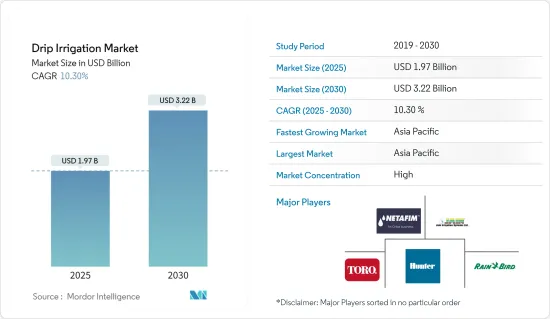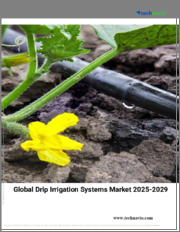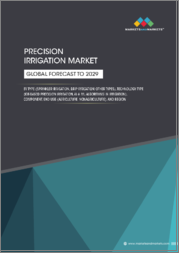
|
시장보고서
상품코드
1689701
점적 관개 - 시장 점유율 분석, 산업 동향 및 통계, 성장 예측(2025-2030년)Drip Irrigation - Market Share Analysis, Industry Trends & Statistics, Growth Forecasts (2025 - 2030) |
||||||
점적 관개 시장 규모는 2025년에 19억 7,000만 달러에 이르고 예측 기간(2025-2030년)의 CAGR은 10.3%를 나타내 2030년에는 32억 2,000만 달러에 달할 것으로 전망됩니다.

주요 하이라이트
- 관개는 농업과 작물 생산에 필수적인 요소입니다.
- 점적 관개 시스템은 물 부족이 점점 더 심각해짐에 따라 높은 수요를 목격하고 있습니다. 예를 들어, 점적 관개의 채용은 캐나다 전토, 특히 물 부족으로 농업 생산에 대한 물 사용량이 많은 주에서 확대하고 있습니다.
- 최근 여러 지역에서 점적 관개의 도입이 증가하고 있습니다. 아시아태평양은 점적 관개 산업에 가장 큰 시장입니다. 2002년 2월 인도농업·농업종사자 복지성은 국내 순관개 면적이 6,864만 9,000ha임을 나타냈습니다. 그 중 점적 관개는 611만 2,050ha, 스프링클러 관개는 679만 6,390ha이었습니다. 사탕수수, 바나나, 오크라, 파파야, 고야, 기타 일부 작물의 재배에 점적 관개 시스템을 채용하면, 사용하는 물의 최대 60%를 절약할 수 있습니다.
- 점적 관개 시스템 시장에 진입하는 주요 시장 진출기업은 Jain Irrigation Systems Limited, Netafim Limited, Toro Company 등이 있으며, 세계의 점적 관개 시장은 통합된 시장이 되고 있습니다. Limited가 경영 통합하여 세계 최대급의 점적 관개 시스템 프로바이더가 됩니다.
점적 관개 시장 동향
작물 유형별로 농작물이 주요 부문
FAO에 따르면 경작지의 약 70%는 곡물의 재배에 사용되고 있습니다. 그 결과, 이 부문에서 정밀 관개의 이용이 증가하고 있습니다.
쌀, 밀, 옥수수는 세계에서 재배되고 있는 주요 곡물입니다.이 작물은 전통적으로 천수 재배되어 왔지만, 관개에 의한 호영향을 평가하기 위해서 행해진 다양한 실지 검사나 연구의 결과, 관개 시스템 수요가 높아지고 있습니다. 폴란드에서 실시한 연구에서는 옥수수의 평균 수율이 종래의 관개 방법에 비해 25% 증가했습니다.동일한 실험에서는 드립에 의한 관개도 실시되어, 1헥타르당의 평균 수율이 2.35톤 증가하여, 이 방법의 효율의 중요성이 결론지어졌습니다.
과학 기술의 진보로 현장 수준의 드립 시스템에 IoT나 자동화가 적용되게 되었습니다. 없이 쉽게 관개를 할 수 있다는 점이 매력이 됩니다. Mantri Krishi Sinchayi Yojana)라는 특별한 제도가 있어, 농업 종사자의 물 이용 효율에 대한 의식을 향상시켜, 보조금을 내는 것으로 정밀 관개를 추진하고 있습니다. 기타, 네타핌은 2022년, 일본의 건전지에서 점적 관개를 사용한 벼농사의 도입 프로젝트를 시작했습니다.
아시아태평양이 시장을 독점
아시아태평양의 농업 섹터에서 점적 관개를 사용하면 최근 몇 년간 현저한 성장을 보이고 있습니다. Aayog에 따르면 2022-2023년에 걸쳐 관개 면적은 7,300만 헥타르에 이르며 농지 전체의 52%를 차지했습니다. 중국국가통계국에 따르면 중국의 관개 면적은 2021년에는 6,961만 헥타르에 달했고, 2022년에는 7,036만 헥타르 증가했습니다.
또한 점적 관개의 실시 면적은 안도라 프라데시 주에서 높고, 마하라슈트라 주, 구자라트 주, 펀자브 주가 이어지고 있습니다. 환경을 홍보하고 이러한 주에서 성공적인 점적 관개 모델을 구현하기 위해, 네타핌은 점적 관개 시스템을 제공했습니다. 디아 프라데시 주 시부푸리 현의 카주리, 콜라라스, 포할리 지역에 있는 4개의 베터 라이프 퍼밍(BLF) 센터를 통해 토마토 생산자에게 점적 관개 시스템을 제공했습니다.
중국은 점적 관개 장비의 세계 최대 시장이며 소비국입니다. 이는 주로 2030년까지 관개 총 면적의 75% 이상에 마이크로 관개 시스템을 도입하는 5개년 계획의 일환으로 고효율의 절수형 관개 기술과 시스템을 농장에 도입하는 것을 정부가 목표로 하고 있기 때문입니다. 또한 정부는 종종 점적 관개 회사와 협력하여 농업 종사자에게 절수 장비 공급을 늘리고 있습니다. 예를 들어, 2022년 11월, 클라우드 남부 전무 지방 정부는 Dayu Irrigation Group과 제휴하여 2038년까지 333만 미터 이상의 점적 관개 파이프와 120만 드리퍼 배포를 위해 PPP(관민 파트너십) 프로젝트 모드에서 협력할 예정입니다.
점적 관개 산업 개요
세계의 점적 관개 시장은 통합되어 있으며 대기업이 시장 점유율의 대부분을 차지하고 있습니다. 시장의 주요 기업으로는 Netafim Limited, Jain Irrigation Systems Limited, The Toro Company, Hunter Industries, Rain Bird Corporation 등이 있습니다. 가장 채택된 전략은 시장에 혁신적인 신제품을 투입하여 제품 포트폴리오를 확대하는 것입니다. 기타 유력 기업들은 제휴와 합병을 통해 지위를 강화하고 있습니다.
기타 혜택
- 엑셀 형식 시장 예측(ME) 시트
- 3개월간의 애널리스트 서포트
목차
제1장 서론
- 조사의 전제조건과 시장 정의
- 조사 범위
제2장 조사 방법
제3장 주요 요약
제4장 시장 역학
- 시장 개요
- 시장 성장 촉진요인
- 물 부족의 위협
- 정부에 의한 호의적인 시책과 보조금
- 관개의 적응 확대
- 시장 성장 억제요인
- 고액의 초기 설비 투자
- 복잡한 셋업에 의한 점적 관개의 손해
- Porter's Five Forces 분석
- 신규 참가업체의 위협
- 구매자/소비자의 협상력
- 공급기업의 협상력
- 대체품의 위협
- 경쟁의 강도
제5장 시장 세분화
- 용도
- 표면 점적 관개
- 지표면 점적 관개
- 작물 유형
- 밭 작물
- 채소 작물
- 과수원 작물
- 포도밭
- 기타
- 지역
- 북미
- 미국
- 캐나다
- 멕시코
- 기타 북미
- 유럽
- 독일
- 영국
- 프랑스
- 러시아
- 스페인
- 기타 유럽
- 아시아태평양
- 인도
- 중국
- 일본
- 기타 아시아태평양
- 남미
- 브라질
- 아르헨티나
- 기타 남미
- 중동 및 아프리카
- 아랍에미리트(UAE)
- 사우디아라비아
- 기타 중동 및 아프리카
- 북미
제6장 경쟁 구도
- 가장 채용된 전략
- 시장 점유율 분석
- 기업 프로파일
- Jain Irrigation Systems Ltd
- The Toro Company
- Netafim Limited
- Rain Bird Corporation
- Chinadrip Irrigation Equipment Co. Ltd
- Antelco Pty Ltd
- TL Irrigation
- Sistema Azud
- Metzer Group
- Hunter Industries Inc.
제7장 시장 기회와 앞으로의 동향
KTH 25.05.12The Drip Irrigation Market size is estimated at USD 1.97 billion in 2025, and is expected to reach USD 3.22 billion by 2030, at a CAGR of 10.3% during the forecast period (2025-2030).

Key Highlights
- Irrigation is a critical component of agriculture and crop production. Manufacturers have created equipment and techniques to provide farmers with paramount drip irrigation systems. Factors such as government subsidies and policies, technological innovations, and increasing concern over water scarcity drive the market.
- The drip irrigation system is witnessing high demand as water has increasingly become scarce. Farmers have been seeking novel ideas to grow more crops with the same quantity of water. This is anticipated to augment the growth of the market studied. For instance, the adoption of drip irrigation is growing across Canada, particularly in provinces with water scarcity and high water usage for agricultural production. According to Statistics Canada, Canadian farmers increased their water usage for crop irrigation by 23% in 2022 compared to 2020, which is majorly attributed to the drier climatic conditions in various regions throughout the country.
- In recent years, drip irrigation implementation has increased in different regions. The Asia-Pacific has the largest market for the drip irrigation industry. India is the largest market in Asia-Pacific for drip irrigation. In February 2021, the Ministry of Agriculture and Farmers Welfare, India, showed that the net irrigated area in the country is 68,649 thousand ha. The agricultural land covered under micro-irrigation is 12,908.44 thousand ha, in which drip irrigation is 6,112.05 thousand ha and sprinkler irrigation is 6,796.39 thousand ha. This means that out of the total irrigated land in the country, only 19% is under micro-irrigation. Up to 60% of water used for sugarcane, banana, okra, papaya, bitter gourd, and a few other crops could be saved if a drip irrigation system is employed for cultivation.
- The major market players operating in the drip irrigation systems market include Jain Irrigation Systems Limited, Netafim Limited, the Toro Company, etc., making the global drip irrigation market a consolidated marketplace. These market players are involved in several strategic planning, product development activities, and mergers and acquisitions, catalyzing the market's growth. Recently, in June 2022, Rivulis Irrigation India Ltd and Jain Irrigation Systems Limited merged their business and will be one of the largest global drip irrigation system providers.
Drip Irrigation Market Trends
Field Crops is the Significant Segment by Crop Type
According to the FAO, about 70% of the cultivated land was used to grow cereals, as most cereals, such as rice and maize, are water-intensive crops. The increasing global population is pressuring farmers to enhance cereal production worldwide, thus leading to the increased use of precision irrigation in this segment. As per the FAO report, world cereal production in 2022 reached a record high of 3,059.6 million metric tons from 3,003.6 million metric tons in 2020.
Rice, wheat, and maize account for the prominent cereal crops cultivated around the globe. Though these crops were grown as rainfed traditionally, results of various field trials and studies conducted to evaluate the positive impacts of irrigating these crops have strengthened the demand for irrigation systems. For instance, in a study conducted in Poland in 2023, the average yield of maize was increased by 25% compared to traditional irrigation methods. In the same experiment, fertigation through drip was also practiced, increasing the average yield by 2.35 metric tons per hectare, concluding the significance of this method's efficiency.
Advances in science and technology led to the application of IoTs and automation in drip systems at the field level. These moments attract farmers, creating a scope for drip irrigation suppliers and companies where the point of attraction is easier irrigation with no labor and time boundness. Governments are also taking initiatives for sustainable growth practices by conserving water. Recently, in India, Pradhan Mantri Krishi Sinchayi Yojana (PMKSY) is a special scheme that promotes precision irrigation practices by subsidizing and improving farmers' awareness of water use efficiency. Besides, in 2022, Netafim started an introductory rice cultivation project in dry fields in Japan using drip irrigation. The system reduces water and fertilizer waste and encourages a shift to sustainable production that reduces methane gas emissions.
Asia-Pacific Dominates the Market
The drip irrigation usage in the Asia Pacific agriculture sector witnessed significant growth during recent years, which is majorly due to the growing area under irrigation due to the expansion of micro-irrigation projects, which can reduce water consumption. In 2022-2023, the area under irrigation was expected to reach 73 million hectares, accounting for 52% of the total agricultural land, which is 41% higher than in 2016, according to the Niti Aayog. Likewise, according to the National Bureau of Statistics of China, the irrigated area in China accounted for 69.61 million hectares in 2021 and had risen by 70.36 million hectares in 2022, thereby delivering high demand for drip irrigation in the market.
Besides, the area under drip irrigation was higher in Andra Pradesh, followed by Maharashtra, Gujarat, and Punjab. To encourage a conductive farming environment and implement the successful drip irrigation model across these states, Netafim is providing drip irrigation systems. In 2023, under the initiative, Netafim provided drip irrigation systems for tomato growers through four Better Life Farming (BLF) Centers present in the Khajuri, Kolaras, and Pohari regions of the Shivpuri district in Madhya Pradesh. This initiative increased the tomato crop yield by 40%, resulting in higher adoption of drip irrigation systems in Maharashtra.
China is one of the world's largest markets and consumers of drip irrigation equipment. This is mainly attributed to the government's aim to equip farms with highly efficient water-saving irrigation technology and systems as part of its five-year plans to equip at least 75% of the total irrigated area with micro-irrigation systems by 2030. Further, The government often works with drip irrigation companies to increase the availability of water-saving equipment to farmers. For instance, in November 2022, the Local Government of Yuanmou in Yunnan Province partnered with Dayu Irrigation Group Co. Ltd, which will work together in a PPP (Public-Private Partnership) Project mode for the distribution of drip irrigation pipes of over 3.33 million meters and 1.2 million drippers till 2038.
Drip Irrigation Industry Overview
The global drip irrigation market is consolidated, with major players occupying most of the market share. Some key players in the market include Netafim Limited, Jain Irrigation Systems Limited, The Toro Company, Hunter Industries, and Rain Bird Corporation. The most adopted strategy is broadening the product portfolio by introducing new and innovative products into the market. The other prominent players are strengthening their position through partnerships and mergers.
Additional Benefits:
- The market estimate (ME) sheet in Excel format
- 3 months of analyst support
TABLE OF CONTENTS
1 INTRODUCTION
- 1.1 Study Assumptions and Market Definition
- 1.2 Scope of the Study
2 RESEARCH METHODOLOGY
3 EXECUTIVE SUMMARY
4 MARKET DYNAMICS
- 4.1 Market Overview
- 4.2 Market Drivers
- 4.2.1 Threat of Water Scarcity
- 4.2.2 Favorable Policies and Subsidies from the Government
- 4.2.3 Increasing Adaptation of Fertigation
- 4.3 Market Restraints
- 4.3.1 High Initial Capital Investments
- 4.3.2 Damages in Drip Irrigation Due to the Complex Set-up
- 4.4 Porter's Five Forces Analysis
- 4.4.1 Threat of New Entrants
- 4.4.2 Bargaining Power of Buyers/Consumers
- 4.4.3 Bargaining Power of Suppliers
- 4.4.4 Threat of Substitute Products
- 4.4.5 Intensity of Competitive Rivalry
5 MARKET SEGMENTATION
- 5.1 Application
- 5.1.1 Surface Drip Irrigation
- 5.1.2 Subsurface Drip Irrigation
- 5.2 Crop Types
- 5.2.1 Field Crops
- 5.2.2 Vegetable Crops
- 5.2.3 Orchard Crops
- 5.2.4 Vineyards
- 5.2.5 Other Crops
- 5.3 Geography
- 5.3.1 North America
- 5.3.1.1 United States
- 5.3.1.2 Canada
- 5.3.1.3 Mexico
- 5.3.1.4 Rest of North America
- 5.3.2 Europe
- 5.3.2.1 Germany
- 5.3.2.2 United Kingdom
- 5.3.2.3 France
- 5.3.2.4 Russia
- 5.3.2.5 Spain
- 5.3.2.6 Rest of Europe
- 5.3.3 Asia-Pacific
- 5.3.3.1 India
- 5.3.3.2 China
- 5.3.3.3 Japan
- 5.3.3.4 Rest of the Asia-Pacific
- 5.3.4 South America
- 5.3.4.1 Brazil
- 5.3.4.2 Argentina
- 5.3.4.3 Rest of South America
- 5.3.5 Middle East & Africa
- 5.3.5.1 United Arab Emirates
- 5.3.5.2 Saudi Arabia
- 5.3.5.3 Rest of the Middle East & Africa
- 5.3.1 North America
6 COMPETITIVE LANDSCAPE
- 6.1 Most Adopted Strategies
- 6.2 Market Share Analysis
- 6.3 Company Profiles
- 6.3.1 Jain Irrigation Systems Ltd
- 6.3.2 The Toro Company
- 6.3.3 Netafim Limited
- 6.3.4 Rain Bird Corporation
- 6.3.5 Chinadrip Irrigation Equipment Co. Ltd
- 6.3.6 Antelco Pty Ltd
- 6.3.7 T-L Irrigation
- 6.3.8 Sistema Azud
- 6.3.9 Metzer Group
- 6.3.10 Hunter Industries Inc.



















